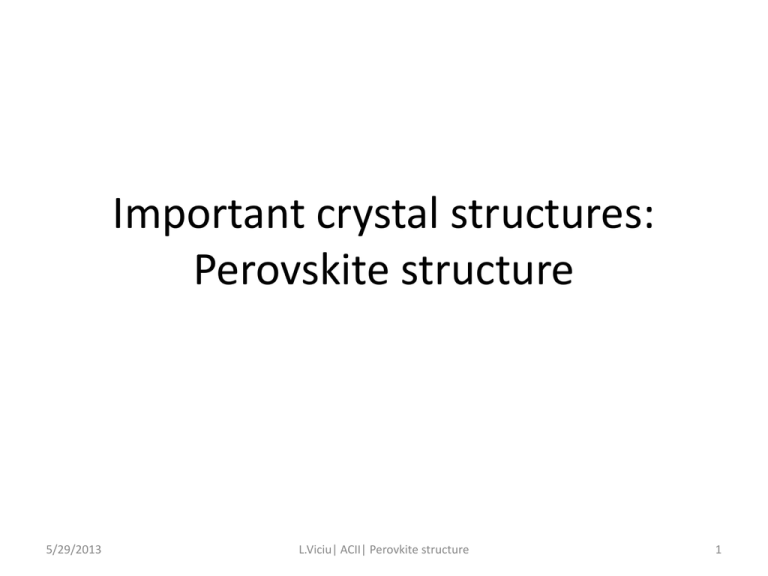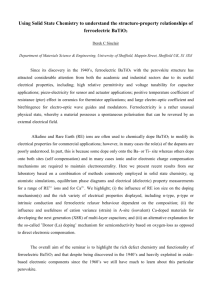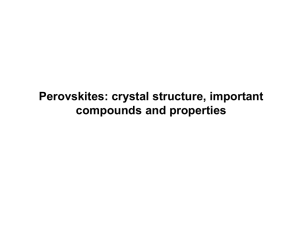Important crystal structures: Perovskite structure
advertisement

Important crystal structures:
Perovskite structure
5/29/2013
L.Viciu| ACII| Perovkite structure
1
A. Structures derived from cubic close packed
1. NaCl- rock salt
2. CaF2 – fluorite/Na2O- antifluorite
3. diamond
4. ZnS- blende
B. Structures derived from hexagonal close packed
1. NiAs – nickel arsenide
2. ZnS – wurtzite
3. CdI2 – cadmium iodide
4. CdCl2 – cadmium chloride
C. Non close packed structures
1. CsCl – cesium chloride
2. MoS2 - molybdenite
D. Metal oxide structures
1. TiO2- rutile
2. ReO3 – rhenium trioxide
3. CaTiO3 – perovskite
4. MgAlO4 - Spinel
5/29/2013
L.Viciu| ACII| Perovkite structure
2
Perovskites: ABO3
http://en.wikipedia.org/wiki/File:Perovskite_mineral.jpg
CaTiO3
CaTiO3 mineral was discovered in the Ural mountains (Rusia) in 1839
and is named after Russian mineralogist L.A. Perovski (1792–1856)
5/29/2013
L.Viciu| ACII| Perovkite structure
3
Perovskite: SrTiO3
Ti at (0, 0, 0);
Corner shared TiO6 Oh
Face shared SrO12 cuboctahedra
Sr at (1/2, 1/2, 1/2)
3O at (½, 0, 0),(0, ½, 0) and (0, 0, ½ )
Ti-O-Ti linear arrangement
0, 1, ½
½
0, 1
0, 1, ½
5/29/2013
0, 1
ABO3
• A: 12-coordinate by O (cuboctahedral)
• B: 6-coordinate by O (octahedral)
(A fills the vacant centered cubic site in
ReO3)
L.Viciu| ACII| Perovkite structure
4
Elements found in the perovskite structure
ABO3 - two compositional variables, A and B
5/29/2013
L.Viciu| ACII| Perovkite structure
5
Perovskite - an Inorganic Chameleon
• CaTiO3 - dielectric
• NaxWO3 - mixed conductor;
electrochromic
• BaTiO3 - ferroelectric
• SrCeO3 - H - protonic
conductor
• Pb(Mg1/3Nb2/3)O3 - relaxor
ferroelectric
• Pb(Zr1-xTix)O3 - piezoelectric
• (Ba1-xLax)TiO3 - semiconductor
• (Y1/3Ba2/3)CuO3-x superconductor
5/29/2013
• RECoO3-x - mixed conductor
• (Li0.5-3xLa0.5+x)TiO3 - lithium ion
conductor
• LaMnO3-x - Giant magnetoresistance
L.Viciu| ACII| Perovkite structure
6
Close Packed??
• Not traditional close packing - mixed cation (A) and anion
SrTiO3
AO3 (SrO3) c.c.p. layers
West book
ideal Perovskite: the cubic cell axis (a) can be related to the ionic radii
a 2rB rO
2rA rO
; rA + rO=2(rB + rO)
2
Examples: NaNbO3 , BaTiO3 , CaZrO3 , YAlO3 , KMgF3
Many undergo small distortions due to size effects and electronic configuration of the B ion
5/29/2013
L.Viciu| ACII| Perovkite structure
7
Size effects in perovskites (ABO3)
t
rA rO "tolerance factor "
2 rB rO
0.8 < t < 1.0 perovskite structure;
t > 1, B ion requires a smaller site;
t < 0.8, the distorted perovskite structure is no longer stable and A ion needs a smaller
0.8
site
0.89
orthorhombic
(GdFeO3)
GdFeO3 (t=0.81)
5/29/2013
1.0
cubic
(SrTiO3)
SrTiO3
L.Viciu| ACII| Perovkite structure
hexagonal
(BaNiO3)
BaNiO3 (t=1.13)
t
8
perovskite structure: great stability
allowed variation in the tolerance factor (t) and the subsequent distortions with
the preservation of the basic framework
A and B sites are relatively insensitive to charge distributions:
ex: various valence combinations for A and B cations
1 : 5 NaTaO3;
2 : 4 SrTiO3
3 : 3 LaMnO3
The structure can withstand considerable departures from ideal stoichiometry:
ex: O2- deficiency: La0.5Sr0.5TiO2.5 (50% oxygen deficient LaTiO3 )
CaFeO2.5 (the product of CaO and Fe2O3 in air)
A deficiency: La1/3TaO3; La1/3NbO3;
5/29/2013
L.Viciu| ACII| Perovkite structure
9
d0 transition metals in perovskite structure
Mn+
O2-
O1
Nb
LUMO or
Conduction
Band (CB)
O2
O3
HOMO or
Valence Band (VB)
Out of center distortion
Schematic electronic structure of an undistorted d0 MO6
• Small gap between HOMO and LUMO allows for symmetry distortion
•This distortion is called Jahn-Teller effect of the second order
•The distortion is favored because it stabilizes the HOMO, while destabilizing the LUMO
Bhuvanesh, N. S. P. and Gopalakrishnan, J.; J. Mater. Chem., 1997, 7(12), 2297–2306
5/29/2013
L.Viciu| ACII| Perovkite structure
10
Jahn-Teller of the second order
The 2nd order JT distortion reduces the symmetry and widens the band gap
The stabilization of HOMO disappears when electrons start filling the band
i.e. for a d1 ion - ReO3 is cubic
1. Octahedrally coordinated high valent d0 cations (i.e. Ti4+, Nb5+, W6+, Mo6+).
BaTiO3, KNbO3 (favored as the HOMO-LUMO splitting decreases - covalency
of the M-O bonds increases)
2. Cations containing filled valence s shells (Sn2+, Sb3+, Pb2+, Bi3+)
Red PbO, SnO, Bi4Ti3O12, Ba3Bi2TeO9 (2nd order JT distortion leads to
development of a stereoactive electron-lone pair)
5/29/2013
L.Viciu| ACII| Perovkite structure
11
BaTiO3
(1) At temp. >120ᵒC : cubic perovskite structure
(a=4.018Å)
(2) At temp.< 120ᵒC : tetragonal structure (a=3.997Å,
c=4.031 Å)
Views on the [100] direction = a axis
(1)
(2)
the tetragonal distortion leads to
an off-centre displacement of Ti4+
and the dipoles are pointing along c
axis
c
cubic
tetragonal
tetragonal BaTiO3 is ferroelectric
5/29/2013
L.Viciu| ACII| Perovkite structure
12
Polarization due to out of center displacement of d0 ions
O1
Nb
Ti in (b)
O2
0.1 – 0.2Å
Ti in (a)
-
O3
(a) Ti position in cubic
Oh coordiantion
(b) Ti displacement
Displacement by 5-10% Ti-O bond
length creates a net dipole moment
The ordering of the displaced ions in the perovskite structure depends on:
1. The valence requirements of anions
2. Cation-cation repulsions
An applied electric field can reverse the dipole orientations the structure is polarisable
Random dipole orientations = paraelectric
5/29/2013
L.Viciu| ACII| Perovkite structure
Aligned dipole orientation
= ferroelectric
13
Properties of d0 transition metals perovskites
BaTiO3-first piezoelectric material discovered
SrTiO3 : Insulator, normal dielectric
BaTiO3 : Ferroelectric (Tc ~ 130°C)
PbTiO3 : Ferroelectric (Tc ~ 490°C)
KNbO3 : Ferroelectric (Tc ~ x)
KTaO3 : Insulator, normal dielectric
5/29/2013
L.Viciu| ACII| Perovkite structure
14
SrTiO3
vs.
BaTiO3
rBa2+=1.35Å
rSr2+=1.13Å
Square pyramidal
coordination (TiO5)
Sr2+
ion is a good fit (d(Ti-O)=1.949Å),
(SrTiO3 is close to a ferroelectric instability)
5/29/2013
Ba2+ ion stretches the octahedra (d(TiO)2 Å) this lowers the energy of LUMO
2nd order Jahn-Teller distortion
L.Viciu| ACII| Perovkite structure
15
KNbO3
vs.
Ferroelectric
KTaO3
Normal dielectric
Similar bonds and behavior
like in BaTiO3
Ta 5d orbitals are more electropositive and have a larger spatial extent
than Nb 4d orbitals (greater spatial overlap with O 2p), both effects
raise the energy of the t2g LUMO no Jahn-Teller distortion in KTaO3
5/29/2013
L.Viciu| ACII| Perovkite structure
16
Applications of ferroelectrics
For practical applications, the ferroelectric transition should be close
to room temperature
BaTiO3-used as capacitor (storing electric charge) with large
capacitance
The most important piezoelectric is PZT (PbZrO3 + PbTiO3)- used for
sensors, capacitors, actuators and ferroelectric RAM chips
PZT = Pb[ZrxTi1-x]O3 best for x0.5
5/29/2013
L.Viciu| ACII| Perovkite structure
17
3dn transition metals in perovskites
Compound
Electrical Property
Magnetic Property
SrTiO3 (d0)
Insulating
Diamagnetic
SrVO3 (d1)
Metallic
Pauli paramagnetism
SrCrO3 (d2)
Metallic
Pauli paramagnetism
CaMnO3 (d3)
Semiconductor
Antiferromagnetic
LaMnO3-(d3)
Colossal magnetoresistance
Antiferromagnetic
SrFeO3 (d4)
Metallic
Spiral antiferromagnetic
Unpaired electrons in the d shell leads to magnetic interactions through the oxygen
p orbitals
Dramatic change in resistivity in an applied magnetic field gives rise to colossal
magnetoresistance
Pauli paramagnetism is the paramagnetism induced by the excited conduction
electrons
L.Viciu| ACII| Perovkite structure
5/29/2013
18
Magnetism in perovskites
There are two interaction mechanisms :
1. superexchange that leads to antiparallel spin alignment
2. double exchange that leads to parallel spin alignment
(2) Double exchange
(1) Superexchange
eg
d-orbital (M)
p-orbital (X) d-orbital (M)
t2g
Mn4+ (d3)
Mn3+ (d4)
Mn3+ (d4)
Antiparallel or Antiferromagnetic
Mn4+ (d3)
5/29/2013
L.Viciu| ACII| Perovkite structure
O2-
O2-
Mn4+ (d3)
Mn3+ (d4)
Parallel or Ferromagnetic
19
Layered perovskites
Dion-Jacobson,
A[A’n-1BnRbLaNb
O3n+1]2 O7
Ruddlesden-Popper,
A2[A’n-1BnO3n+1]
(AO)(ABO3)n
Aurivillius,
(Bi2O2)[An-1MnO3n+1]
NbO6
La
NbO6
Rb
NbO6
La
AO Rock
salt
layers
Bi2O2
(fluorite
like
layer)
NbO6
suitable systems for investigation the two-dimensional physical properties
5/29/2013
L.Viciu| ACII| Perovkite structure
20
Bi4Ti3O12=(Bi2O2)Bi2Ti3O10
Bi3TiNbO7=(Bi2O2)BiTiNbO7
n=2
n=3
Bi2O2
(fluorite
like
layer)
5/29/2013
L.Viciu| ACII| Perovkite structure
21
Ruddlesden-Popper (R.P.) phases of Ruthenium: (AO)n+1(RuO2)n:
1. Ca3Ru2O7 (n=2): Mott – Hubbard insulator
2. CaRuO3 (n=): paramagnet (becomes
ferromagnetic upon chemical doping)
3. SrRuO3 (n=): ferromagnetic
4. Sr3Ru2O7 (n=2): metamagnet
5. Sr2RuO4 (n=1): superconducting at 1 K
Sr2RuO4
5/29/2013
L.Viciu| ACII| Perovkite structure
22
La2CuO4
It may be viewed as if constructed from an …ABAB... arrangement of Perovskite cells
Also known as an intergrowth structures
A
B
A
The transparent atoms are missing
Sheets of elongated CuO6
Oh sharing only corners
5/29/2013 L.Viciu| ACII| Perovkite structure
23
Doped La2-xSrxCuO4 {La2-xSrxCuO4 } was the first (1986)
High-Tc Superconducting Oxide (Tc ~ 40 K) for which
Bednorz & Müller were awarded a Nobel Prize
The first of the ‘‘High Tc superconductors’’ discovered,
La1.85Sr0.15CuO4, has the same basic crystal structure as Sr2RuO4, with
some subtle but important differences due to the difference in d
orbital occupancy.
5/29/2013
L.Viciu| ACII| Perovkite structure
24
Perovskite –type superconductors: YBa2Cu3O7-x
(superconducts over 77 K (Boiling point of N2)
2 out of 6 O-Positions in
the structure are
unoccupied
Cu-Atom coordination:
Perovskit
CaTiO3
Y
1/3 square-planar
2/3 square-pyramidal
Triple unit cell
YBa2Cu3O7-x
5/29/2013
L.Viciu| ACII| Perovkite structure
25
1-2-3 Superconductors
YBa2Cu3O7-x ( x < 0.1): Tc = 93K
CuO
chains
O(1)
Ba
O(2)
Y
CuO2
planes O(3)
O(4)
Ba
2 out of 6 O-Positions of the
Perovskites are unoccupied
YBa2Cu3O7-x (x 0.07 optimum for
highest Tc)
Perovskit 3 unit cells (A=Ba, A‘=Y, B=Cu)
5/29/2013
26
L.Viciu| ACII| Perovkite structure
YBa2Cu3O7-
= 0.08 Tc=93K
> 0.56 not superconductor (tetragonal structure)
400 C , O
2 orthorhombic
tetragonal
O (1) site almost missing
5/29/2013
CuO2 planes are the SC layers
L.Viciu| ACII| Perovkite structure
27
YBa2Cu3O7-x: intergrowth structure
Layers stacked in the sequence:
Cu(1)O–BaO–Cu(2)O2–Y–Cu(2)O2–BaO–Cu(1)O
Cu(1)O
UNIQUE SEQUENCE OF LAYERS:
BaO
1) Charge reservoirs layers (insulating), such
Cu(2)O2
Y
Cu(2)O2
BaO
Cu(1)O
as [Cu(1)O]
2) Spacing layers: such as [BaO]-2 layers
3) Separating layers: such as [Y]-1 layer
4)Superconducting layers [Cu(2)O2]-2 layers
1212
5/29/2013
CuBa2YCu2O7 (YBa2Cu3O7)
L.Viciu| ACII| Perovkite structure
28
Naming Scheme of the cuprates
1223
TlBa2Ca2Cu3O9
Annu. Rev. Mater. Sci. 1997. 27:35–67
5/29/2013
I . the number of insulating layers between adjacent
conducting blocks
II. the number of spacing layers between identical CuO2
blocks
III. the number of layers that separate adjacent CuO2
planes within the conducting block
IV. the number of CuO2 planes within a conducting block.
0201
(La1-xSrx)2CuO4
1212
HgBa2CaCu2O6
1212
CuBa2YCu2O7 (Usually written YBa2Cu3O7)
1223
TlBa2Ca2Cu3O9
2201
Bi2Sr2CuO6
2234
Tl2Ba2Ca3Cu4O12
L.Viciu| ACII| Perovkite structure
29
Changing Properties?
Can substitute many elements into YBa2Cu3O7 structure:
Y lanthanides - no change in Tc
Y other elements - decrease in Tc
Ba Sr, Ca - decrease in Tc
Ba La - very slight increase?
Cu transition metals - decrease in Tc
Cu Au - very slight increase?
Generally detrimental!
Skakle, .Mat. Sci. Eng: R: Reports, 23 1-40 (1998)
It is believed that the superconductivity depends on the number of
CuO2 planes per unit cell
YBa2Cu3O7 (1212): 2 CuO2 layers Tc=93K
Bi2Sr2Ca2Cu3O10 (Bi-2223): 3 CuO2 layers Tc=110K
Tl2Ba2Ca2Cu3O10 (Tl-2223): 3 CuO2 layers Tc=125K
HgBa2Ca2Cu3O8 (Hg-1223): 3 CuO2 layers Tc=134K
5/29/2013
L.Viciu| ACII| Perovkite structure
30
Composition
Physical Property
Possible or present application
CaTiO3
Dielectric
Microwave applications
BaTiO3
Ferroelectric
Non volatile computer memories
PbZr1-xTixO3
Piezoelectric
Sensors
(Pb,La)(Zr,Ti)O3
Optical
Electro-optical modulator
Ba1-xLaxTiO3
Semiconductor
Semiconductor applications
GdFeO3, LaMnO3
Magnetic
Magnetic memories, ferromagnetism
Y0.33Ba0.67CuO3-x
Superconductor
Magnetic detectors
LnCoO3-x
Mixed ionic and electronic
Gas diffusion membranes
conductor
BaInO2.5
Ionic conductor
Electrolyte in solid oxide fuel cells
AMnO3-x
Giant magneto resistance
Read heads in hard disks
YAlO3, KNbO3
Optical
Laser
5/29/2013
L.Viciu| ACII| Perovkite structure
31


